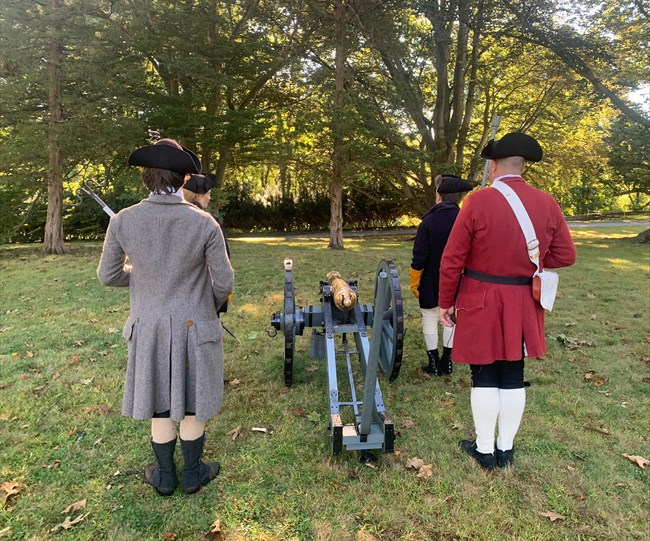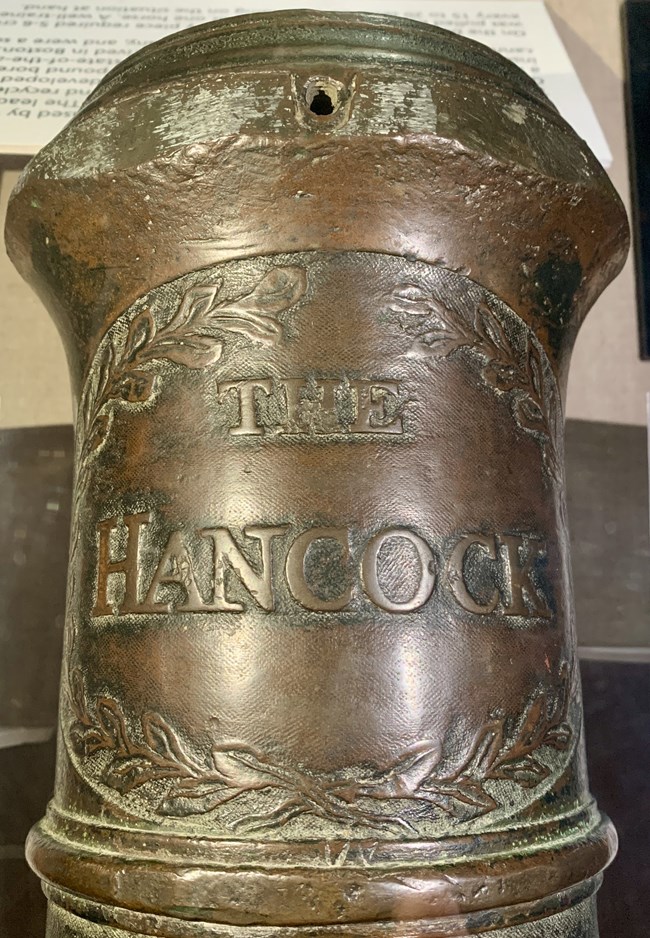Last updated: July 28, 2025
Article
The Hancock Cannon

Gage utilized his sweeping powers to abolish the locally elected Governors Council, establish crown appointed judges across Massachusetts, and began to build military fortifications on Boston neck. Those actions backed by the Royal Navy and a large garrison of British soldiers stationed in Boston inflamed already existing tensions. 2
At the beginning of September 1774, the situation came dangerously close to war. On August 27, 1774, General Gage received accurate intelligence that multiple towns were removing their share of gunpowder from a communal magazine in Charlestown, MA; presumably to have it handy in the event of a “rupture” with the King’s troops. According to the intelligence, the remaining supply was “the King’s powder only,” meaning that only the powder reserved for the government remained. 3
On September 1st, Gage sent a detachment of soldiers to retrieve the King’s powder and confiscate two small cannons in Cambridge. Alarm spread like wildfire across the province. As it did, so too did rumors that the Royal Navy had fired upon Boston and that the soldiers were slaughtering the inhabitants. By the next morning, more than 4,000 angry militia men gathered on the spot in response to what became known as the “Powder Alarm.” From then on, the colonists decided to take a more proactive role in securing their military stockpiles. A dangerous arms race ensued. 4

Two of those pieces stored at the “New Gun House” across from the Boston Common were purchased by the Massachusetts General Court for the militia company in 1766. The thrifty leaders of Boston sent a pair of outdated cannons to England along with the order, to be melted down and recycled into the two new pieces. The new cannons were cast with a three-pound bore (meaning that they fired a ball weighing three pounds) and were engraved with a depiction of the “arms of the Province.” The completed cannons arrived in Boston in 1768 and conformed to a new pattern developed by the British Board of Ordinance in 1764. These state-of-the-art military weapons were two of four cannons used by the Boston artillery company, and were a source of great pride.6
In September of 1774, to the horror of Boston’s artillery company, their commanding officer and known Loyalist, Major Adino Paddock, made arrangements to turn the cannons over to British authorities. On the night of September 14, 1774, company members thwarted those intentions by climbing through the side yard of distiller Francis Johonnot and into the “Old” Gun House where they hastily removed two older pattern guns and smuggled them off into a “dark and stormy night.” 7
Enraged by the loss of the guns, General Gage ordered a double guard placed on the “New Gun House” near the Boston Common. By all accounts, the guns were utterly impossible to access. The brick building remained under constant watch; members of the 4th Regiment of Foot were encamped literally yards away. 8
On the night of September 16, 1774, the provincials struck again. Members of the Boston artillery company waited for the appropriate moment to break in and take back their cannon. The moment came at the changing of the guard just before dawn. Acting quickly, the men pried open a side door, slipped inside and dismounted the cannon barrels. They then carried the artillery pieces over the back wall to a nearby schoolhouse and hid the guns inside a firewood bin. Shortly after, a British officer checking on the cannons noticed they were missing. Shocked at the audacious theft he exclaimed, “Devil must have help’d to get ‘em away.” 9
Over the next few months, a network of confidants slowly smuggled the stolen cannon barrels out of Boston and added them to a growing rebel arsenal in Concord, Massachusetts. The guns were deposited at the farm of militia Colonel James Barrett. All told, by the spring of 1775, the colonists had amassed enough arms and equipment between Concord and Worcester to outfit an army of 15,000 soldiers. During this period, multiple towns also began organizing artillery detachments and acquiring provisions to transport, maintain, and operate their guns. On the battlefield, a 3-pounder artillery piece required 11-crew members to operate and could fire upwards of 2500 yards. When fielded by a well-trained crew, these cannons could decide the outcome of an engagement. 10

Despite Gage’s detailed intelligence and best laid plans, the mission to destroy military goods in Concord turned out to be a miserable failure for the British. Most of the weapons remained safely hidden or were dispersed to surrounding towns. Following a horrific day of bloodshed, the war General Gage hoped to avoid arrived at his doorstep. Within weeks, nearly 20,000 militia men answered the call to arms and besieged Gage’s small garrison in Boston. 12
With war underway, provincial soldiers put many of the weapons and supplies from Concord, including the four-brass cannon of the Boston Artillery Company, to use in the siege lines surrounding Boston. Carpenters and wheelwrights employed by the provincial congress set the guns on new carriages and ushered them to the front. On June 17, 1775, orders arrived for Colonel Barrett to forward all stock of artillery and provisions immediately to the front. 13
After the disastrous use of provincial artillery during the battle of Bunker Hill in June 1775, the newly arrived General George Washington appointed Boston local, and former member of the Boston artillery company, Henry Knox, to oversee organization of the Continental Army artillery. During the next eight years, Knox’s Artillery performed admirably on the battlefield and played a crucial role in securing America’s independence from the British Empire. 14

In 1969, officials removed "The Hancock" cannon from the monument when a bracket holding it to the wall broke. The Commonwealth of Massachusetts, then caretaker of the monument, lost track of the cannon. Twenty years later, in 1989, "The Hancock" surfaced in a state police storage-room not far from the monument. The National Park Service, caretaker of the monument after 1975, put "The Hancock" cannon in archival storage at the Boston National Historical Park in the Charlestown Navy Yard. Today, the gun is proudly displayed at Minute Man National Historical Park in Concord, Massachusetts. 16
1. David Hackett Fischer, Paul Revere’s Ride (New York: Oxford University Press, USA, 1994).; J. L. Bell, The Road to Concord: How Four Stolen Cannon Ignited the Revolutionary War (Yardley, PA: Westholme Publishing, LLC, 2016).
2. Fischer, Paul Revere’s Ride.; Bell, The Road to Concord: How Four Stolen Cannon Ignited the Revolutionary War.
3. “The Following Is a Copy of a Letter, Said to Be Wrote by Gen. Brattle, to the Commander in Chief, Viz. Cambridge, August 29, 1774.,” The Library of Congress, 1774, https://www.loc.gov/resource/rbpe.0370350a/.
4. Rev. Stephen Williams wrote “that the Ships in ye Harbour – of Boston, & ye Army on ye Land Side were also fireing upon ye Town so yt. It was like ye Town was Demolished.” William Stevens, A System for the Discipline of the Artillery of the United States of America; or, the Young Artillerist’s Pocket Companion. Vol. 1, (United States of America, 1799), https://books.google.com/books?id=tAtXAAAAcAAJ&printsec=frontcover&source=gbs_ge_summary_r&cad=0#v=onepage&q&f=false.
5. Bell, The Road to Concord: How Four Stolen Cannon Ignited the Revolutionary War.
6. Bell, The Road to Concord: How Four Stolen Cannon Ignited the Revolutionary War, 49; Boston News-Letter, February 11, 1768.
7. Henry Burbeck in letter to Charles Davies, April 13, 1847, Willard (Knox) papers, as quoted in . Bell, The Road to Concord: How Four Stolen Cannon Ignited the Revolutionary War, 54.
8. Bell, The Road to Concord: How Four Stolen Cannon Ignited the Revolutionary War, 82.
9. Account of John Andrews, September 16, 1774 as quoted in, Bell, The Road to Concord: How Four Stolen Cannon Ignited the Revolutionary War, 55.
10. Bell, The Road to Concord: How Four Stolen Cannon Ignited the Revolutionary War, 52. Numbers of gun crews determined by Liet. Col. Nadal, director of the park of artillery, commanded by Col. D’Abovelle, under the orders of his excellency, Lieut. Hen. Count De Rochambeau, 1781, as quoted in William Stevens, A System for the Discipline of the Artillery of the United States of America; or, the Young Artillerist’s Pocket Companion. Vol. 1, Google Books (United States of America, 1799), 5, 11. https://books.google.com/books?id=tAtXAAAAcAAJ&printsec=frontcover&source=gbs_ge_summary_r&cad=0#v=onepage&q&f=false.
11. “Four Brass Cannon” General Thomas Gage as quoted in Allen French, General Gage’s Informers: New Material Upon Lexington & Concord, Benjamin Thompson as Loyalist & the Treachery of Benjamin Church, Jr.: a Study (Greenwood, 1968). pp 29-30.; The Order given to Lt. Colonel Francis Smith from General Gage, April 18, 1175 as quoted in Vincent J-R Kehoe, We Were There!: April 19th 1775, vol. 1, 1974, 67. https://redcoat.org/archives/WeWereThere_Vol-I.pdf.
12. Douglas Sabin, April 19, 1775: A Historiographical Study, (Minute Man National Historical Park, Concord, 1987); Fischer, Paul Revere’s Ride.
13. Order from General Ward to Col. Barrett, AAS United States Revolution Collection 1754-1928 Box 1 Folder 29. Research provided by Joel Bohy.
14. Richard Frothingham, History of the Siege of Boston: And of the Battles of Lexington, Concord, and Bunker Hill. Also an Account of the Bunker Hill Monument. With Illustrative Documents., The Library of Congress, Fourth (Little, Brown, and Company, 1873), https://www.loc.gov/item/02004522/.; Bell, The Road to Concord: How Four Stolen Cannon Ignited the Revolutionary War.
15. Bell, The Road to Concord: How Four Stolen Cannon Ignited the Revolutionary War.; Patty Owens, Patty Owens, “Lost for 20 Years, Bunker Hill Cannon Is Found,” Boston Globe, March 3, 1989.
16. Owens, “Lost for 20 Years, Bunker Hill Cannon Is Found.”; “Historic Cannon Back on Display,” Boston Globe, April 7, 2005. “The Hancock Returns,” Minute Man National Historical Park (U.S. National Park Service), August 2, 2022, https://www.nps.gov/mima/planyourvisit/the-hancock.htm.

NPS Photo/ Gould
